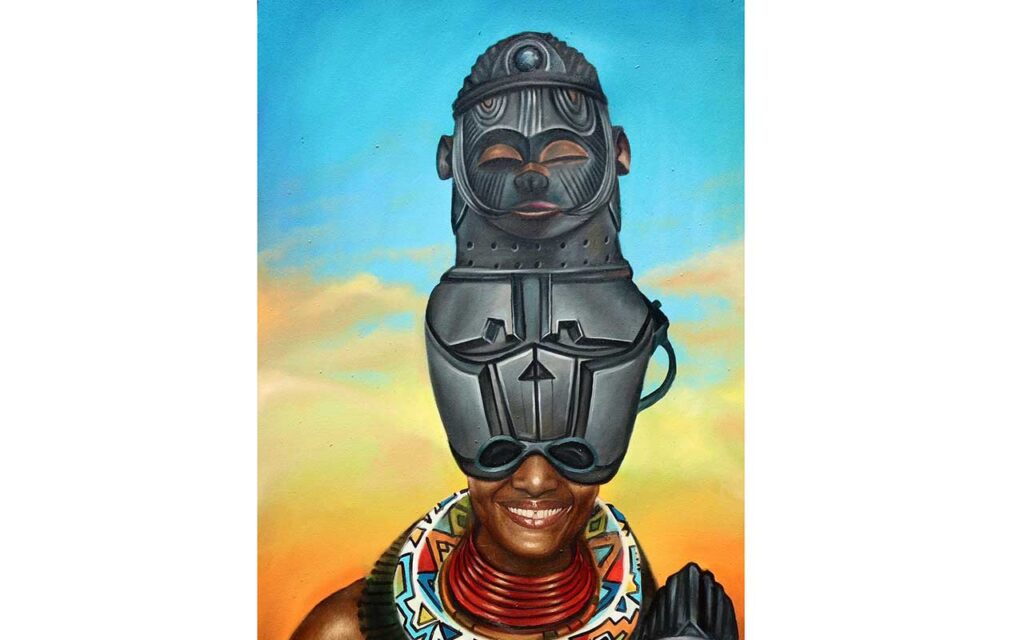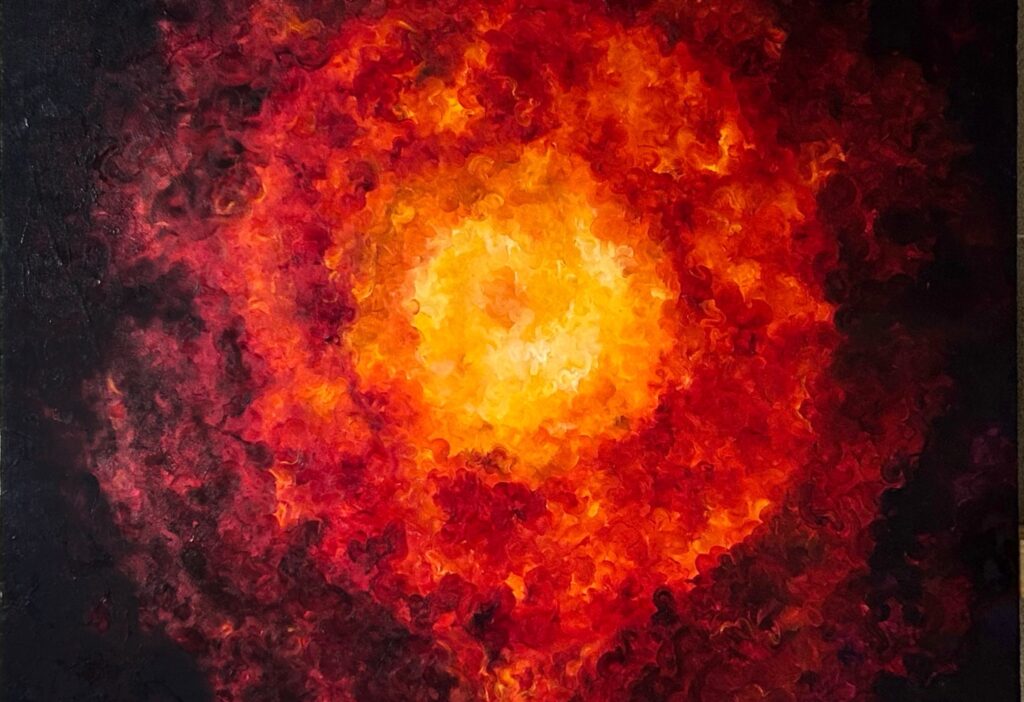
The Yoruba creation myth is what you glean when you first enter John Randle Centre for Yoruba Culture and History, Onikan.
The Yoruba story, which is told in sounds and colours, leaves a visitor to the centre immersed in a narrative structured by deities, rituals, customs and heritage.
The facility, which was unveiled on Tuesday, January 24, 2023, by government functionaries, including President Muhammadu Buhari, who did the tape cutting; the Governor of Lagos, Babajide Sanwo-Olu and his wife, Claudiana Ibijoke; the Deputy Governor, Kadri Obafemi Hamzat and his wife, Mrs. Oluremi; and as well, high networth guests such as Ooni of Ife, Oba Adeyeye Enitan Ogunwusi; (Ojájá II) and Erelu Kuti of Lagos, Abiola Dosunmu.
From a revolving screen that projects the Yoruba account of creation, to the story of Esu (trickster) avatars that define the Yoruba worldview are showcased in carvings and sculptural pieces.
Traditional fabrics, royal ensembles and palace, a weaving loom, paintings, iconic photos, a court for moonlight tales, a folksy, 3D screen depicting the place of Yoruba art and culture in the future, among others, form part of the cultural attractions of the centre: The past, present and future of Yoruba race meet in a ‘convoluting concourse of variegated actions’.
Designed by SI.SA Architects, the centre takes its cues from traditional Yoruba architecture and craftsmanship, using visual metaphors to reflect the strong art and philosophical origins of the language and culture.
The building form responds to its context in the shape of a fractal, rises from the earth and leans forward as a nod to Itesiwaju, reflecting the progressive nature of the Yorubas.
The buildings are finished in a dyed Tyrolean, evocative of the mud aesthetic of old Yoruba architecture. A metallic screen across the face of the curved façade represents a weave, a time-honoured skill found in everyday Yoruba life. A green roof ties the building to the landscape, helps to reduce the building’s thermal load and provides additional interactive outdoor space.
The exhibition gallery is divided into ‘curate zones’— Government (indigenous, colonial, civilian); Industry (arts, agriculture, crafts, minerals); and Culture (spirituality, literature, art, music, media). Together, they showcase an eclectic glimpse into the rich Yoruba culture.
To deepen knowledge of Yoruba worldview, the curatorial notes in practically all the exhibits, help non-Yoruba speakers to understand the history embedded in the works. There is an interactive device built in the form of a self-service kiosk helps non-Yoruba speakers to translate from English to Yoruba.
Throughout the building, there’s a conscious effort to deemphasise the use of English by putting Yoruba words in bigger fonts while the English fonts are captured in squint-worthy sizes.
Mr. Damilare Ojewole, the site architect, who explained the components of the facility to guests and journalists, said the centre would educate visitors on the creation of Yoruba Empire through ‘Ile-Ori’, ‘Ori-Olokun’, ‘Esu’, among others.
He noted: “In this place, you will learn about happenings in the Yoruba empire in the past and now, customs and practices. We also have exhibitions on how naming ceremonies were conducted in the past, and divinations, it reveals the various masquerades in Yoruba land. We have a contemporary art section, fashion, and more.
“At another session, we have a gadget for visitors to check the meaning of their names and we have a good ambience for tales by moonlight.
“The permanent exhibition here celebrates the language, rituals, festivals, deities and ancestry of the Yoruba people at this time, and will ensure that the legacy of Yoruba culture and history is kept alive in Lagos,” he said.
In a chat with journalists at the official commissioning of the centre, the Lagos State Commissioner for Tourism, Arts and Culture, Mrs. Uzamat Akinbile-Yussuf noted that members of the public would pay a token to access the facility. She also noted that the government hopes to get grants to keep it functioning at optimum capacity.
“We are trying to find the best way to smooth the operation of this centre. The board is already in place and the management will be trained to make sure that this place is running efficiently. This place should be open to the public in one or two months.
“The entry will not be free but we hope to get grants to make it sustainable. This is the first and only board that will be chaired by the Governor himself so you can see how passionate he is about this project. He has been working from the front. On several occasions, we have to travel on several international trips to ensure that the space is well-equipped with artefacts to explain the Yoruba history and culture. This is a reminder of who we are and where we need to be. When you don’t understand your past, it will be difficult to know where you are going as a person,’’ she said.
“The John Randle Centre is the first of many initiatives aimed at the preservation of the heritage of the Yoruba through the celebration and preservation of history and culture, the regeneration of decades old public green space, public recreation facilities, and the restoration of civic pride. Onikan will be the catalyst for a vibrant and tourist friendly quarter in the heart of Lagos Island,” said Governor Sanwo-Olu.
The centre will be an unparalleled experience in Lagos – a ground-breaking cultural attraction that will reveal to visitors the time-honoured story of Yoruba ethnicity – one of the most influential ethnicities in Nigeria. Yoruba experts and novices alike will be able to dive deep into the stories, myths and traditions of Yoruba heritage, encountering immersive experiences from the dynamism of Yoruba festivals to the rich visual culture of Yoruba history and ancestry.
The centre is the first cultural centre of its kind in Lagos. As distinct from a museum, the centre is set to provide a flexible, updateable space for learning programmes, art installations and live music events. Visitors will be thrilled, inspired and intrigued by the stories it has to offer, regardless of their ethnicity.
The exhibition at the facility will also celebrate the language, rituals, festivals, deities and ancestry of the Yoruba people at this time, and will ensure that the legacy of Yoruba culture and history is kept alive in Lagos.
“It is an enduring monument to Yoruba civilisation, immortalising Yoruba cultural history’s vast grandeur and influence. The Centre’s exhibits will catalogue profound Yoruba knowledge, spirituality, and existence, providing a hallowed place for all to experience the glamour, splendour, and mystique of an unimaginable global treasure,” a statement by the government said on its website.
It will be a place of remembrance and reconnection for Yoruba and African people from Cuba, Brazil, Haiti, America and the Caribbean, as well as the rest of Nigeria, providing a vital injection of tourism to Lagos.
Dr John Randle, a prominent Lagosian, built a public swimming pool in 1928 in King George V Park, later to become the Love Garden – a much loved recreational area.
This grand gesture was inspired by the refusal of the British Colonial office to build a pool for Lagosians to learn how to swim. On completion of the pool and garden, Randle handed over the facilities to the Lagos Town Council with a maintenance purse to ensure its upkeep.
Chief John Koshoni Randle, an avid sportsman, prominent Lagosian and the son of Dr Randle passed away leading a sports delegation on an international games event. A group of his friends, including Dr Mose Majekodunmi, Chief Akerele, Alhaji Chief IS Adewale, Mr John Stewart, and Chief Kweku Banwo set up a trust to build a hall in memory of Chief Randle. A piece of land in Onikan was donated by the Federal Government of Nigeria on the direction of Hon. Abubakar Tafawa Balewa and executed by Hon. Musa Yar Adua, the Minister of Lagos Affairs.
The memorial hall, under the care of a new set of trustees in Chief (Arc) Femi Majekodunmi, Chief Femi Adeniyi Williams, and Bashorun JK Randle, was extensively used as a performance venue for cultural plays by renowned artists such as Prof. JP Clark, and artists in residence.
The refurbishment of the swimming pool and erection of a new centre to replace the demolished memorial hall will hopefully return this much loved and missed recreational area in the heart of Lagos Island.









